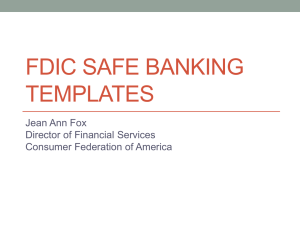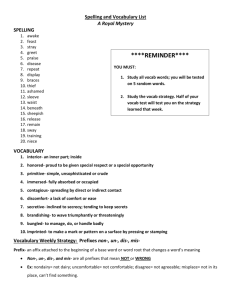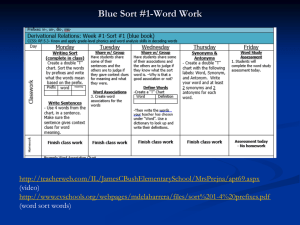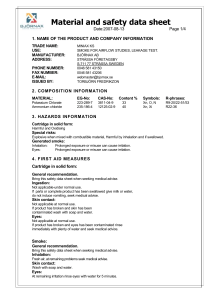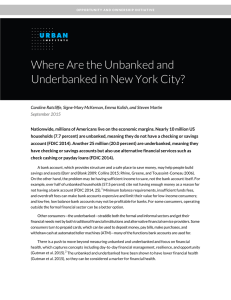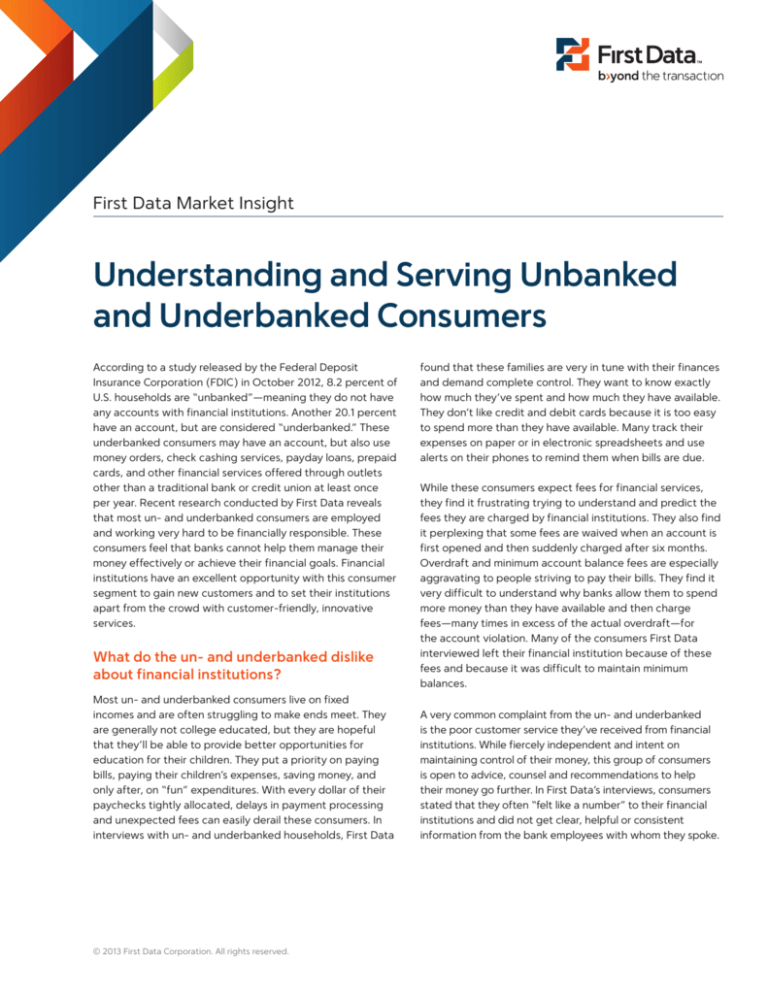
First Data Market Insight
Understanding and Serving Unbanked
and Underbanked Consumers
According to a study released by the Federal Deposit
Insurance Corporation (FDIC) in October 2012, 8.2 percent of
U.S. households are “unbanked”—meaning they do not have
any accounts with financial institutions. Another 20.1 percent
have an account, but are considered “underbanked.” These
underbanked consumers may have an account, but also use
money orders, check cashing services, payday loans, prepaid
cards, and other financial services offered through outlets
other than a traditional bank or credit union at least once
per year. Recent research conducted by First Data reveals
that most un- and underbanked consumers are employed
and working very hard to be financially responsible. These
consumers feel that banks cannot help them manage their
money effectively or achieve their financial goals. Financial
institutions have an excellent opportunity with this consumer
segment to gain new customers and to set their institutions
apart from the crowd with customer-friendly, innovative
services.
What do the un- and underbanked dislike
about financial institutions?
Most un- and underbanked consumers live on fixed
incomes and are often struggling to make ends meet. They
are generally not college educated, but they are hopeful
that they’ll be able to provide better opportunities for
education for their children. They put a priority on paying
bills, paying their children’s expenses, saving money, and
only after, on “fun” expenditures. With every dollar of their
paychecks tightly allocated, delays in payment processing
and unexpected fees can easily derail these consumers. In
interviews with un- and underbanked households, First Data
© 2013 First Data Corporation. All rights reserved.
found that these families are very in tune with their finances
and demand complete control. They want to know exactly
how much they’ve spent and how much they have available.
They don’t like credit and debit cards because it is too easy
to spend more than they have available. Many track their
expenses on paper or in electronic spreadsheets and use
alerts on their phones to remind them when bills are due.
While these consumers expect fees for financial services,
they find it frustrating trying to understand and predict the
fees they are charged by financial institutions. They also find
it perplexing that some fees are waived when an account is
first opened and then suddenly charged after six months.
Overdraft and minimum account balance fees are especially
aggravating to people striving to pay their bills. They find it
very difficult to understand why banks allow them to spend
more money than they have available and then charge
fees—many times in excess of the actual overdraft—for
the account violation. Many of the consumers First Data
interviewed left their financial institution because of these
fees and because it was difficult to maintain minimum
balances.
A very common complaint from the un- and underbanked
is the poor customer service they’ve received from financial
institutions. While fiercely independent and intent on
maintaining control of their money, this group of consumers
is open to advice, counsel and recommendations to help
their money go further. In First Data’s interviews, consumers
stated that they often “felt like a number” to their financial
institutions and did not get clear, helpful or consistent
information from the bank employees with whom they spoke.
First Data Market Insight
Understanding and Serving Unbanked
and Underbanked Consumers
How to win back the trust and service of the
un- and underbanked population
•
Provide an alternative to traditional credit and debit cards
by offering prepaid cards. Fees are low and explained
clearly up front. The cards provide the ability to pay bills by
phone or online, but don’t allow consumers to spend more
money than they’ve loaded to the card.
•
Demonstrate how your online banking system provides
real-time access to their account balances, pending
payments and pending deposits, as well as the ability
to receive alerts and notifications. Many consumers may
simply not know how much control they can have over their
accounts or may be unfamiliar with how online banking
works. The un- and underbanked may not have reliable
Internet access, but frequently have smartphones—so
make sure your online banking system is mobile-friendly.
•
In addition to the legal documents provided about account
fees, provide a simple, one-page account overview that
© 2013 First Data Corporation. All rights reserved.
•
Provide personalized, ongoing recommendations for
additional services or ways these consumers can take
advantage of what your financial institution offers.
•
Above all else, ensure that your telephone customer
service representatives and branch personnel are trained
to be friendly, empathetic and patient. The un- and
underbanked are seeking a personal touch and want to
feel that you value their business and understand their
financial situations and goals.
Be the alternative for which these consumers
are searching
The un- and underbanked are using an assortment of financial
services, but have a low opinion of financial institutions.
Whether these consumers feel they need greater control of
their money or believe they have been victimized by unfair
fees, your institution can help them better understand the
many valuable benefits of the services you offer. By adopting a
customer-centric approach with your services and reaching out
in a clear, friendly way you can gain the trust and loyalty of a
large number of potential new account holders.
page 2
3762
Many un- and underbanked consumers have had negative
experiences with financial institutions and have turned
elsewhere for financial services. Most often, they feel these
alternatives are more convenient, offer more control and are
more transparent about their fees. Your financial institution can
offer the same benefits; you just need to position them in the
right way for this segment.
clearly and simply outlines the parameters of the account
and all of the fees. Review this document in person with
the new account holder, being sure to frequently stop and
ask if they have questions or need clarification.

